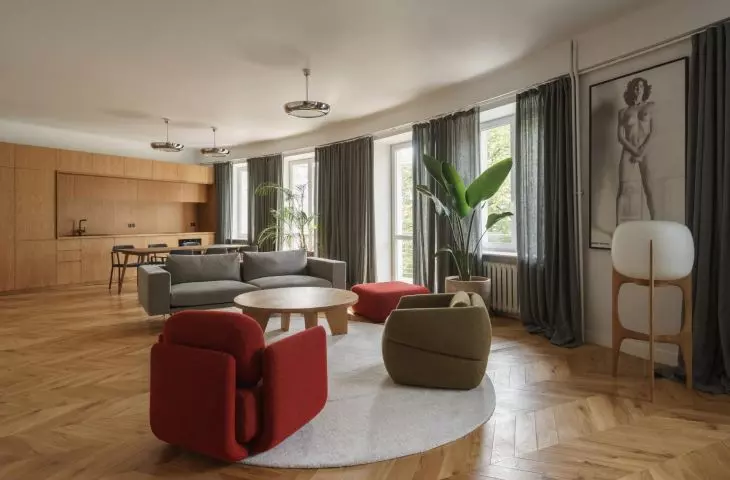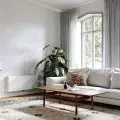Designers from the Loft Kolasinski studio have once again returned to the Old Ochota district and Filtrowa Street. This is their fifth realization in this part of Warsaw. How did they handle this adaptation?
The interior is characterized primarily by openness
Photo by Joel Hauck, © Loft Kolasinski
The realization was named by the studios Ochota 5 Warsaw Filtry 2, which marks the fifth realization in the Ochota district and the second on Filtrowa Street. The apartment is located in a tenement that was built in 1937.
The project included a remodeling of the living area - a smaller room was eliminated to make one large area, which included a kitchen with dining room, living room and office area. An important premise of the project was to refer to the historical character of the apartment.
The kitchen built-ins were made in a uniform material
photo by Joel Hauck, © Loft Kolasinski
The apartment featured furniture designed by the Loft Kolasinski studio. An example is the Brazilian Punk XLlamp. Also visible in the realization are unique armchairs from the 1960s, which underwent specialized restoration. The apartment was a unique challenge for the designers, as the walls were built on an arch plan. A photograph of Helmut Newton was placed in the living room.
In the interior, in addition to furniture, there were also works of art, including a photograph of Helmut Newton
photo by Joel Hauck, © Loft Kolasinski
The designer, Jacek Kolasinski, talks about the concept, the history of creation.
Wiktor Bochenek: This is another of your projects in Warsaw's Ochota district. What is the most important thing when designing historic interiors? Did the layout of the apartment require changes?
Jacek Kolasinski: A typical apartment that was built in the 1920s and 1930s. Simple functional architecture sparing the details. Elimination of one small room, resulted in one large area, which included a kitchen, dining room, living room and workspace. The apartment has another room used as bedrooms and two bathrooms, one in the bedroom and the other accessible from the living room.
The dining room is directly connected to the kitchen and living room
Photo by Joel Hauck, © Kolasinski Loft
Wiktor Bochenek: What was the most challenging part of this project, and what are you most satisfied with?
Jacek Kolasinski: The biggest challenge was to arrange all the mentioned functions in one area, given that the main walls of the building, was created on an arch plan. This is very rare, but also an interesting interior.
I am most pleased with the composition of the apartment's furnishings, with furniture, lamps and accessories from the 1920s, 1960s and contemporary designs gathered on one surface. The whole creates an impressive and coherent composition.
Wiktor Bochenek: Thank you for the interview!
Special attention is drawn to the furniture and its unique details
Photo by Joel Hauck, © Loft Kolasinski




























































